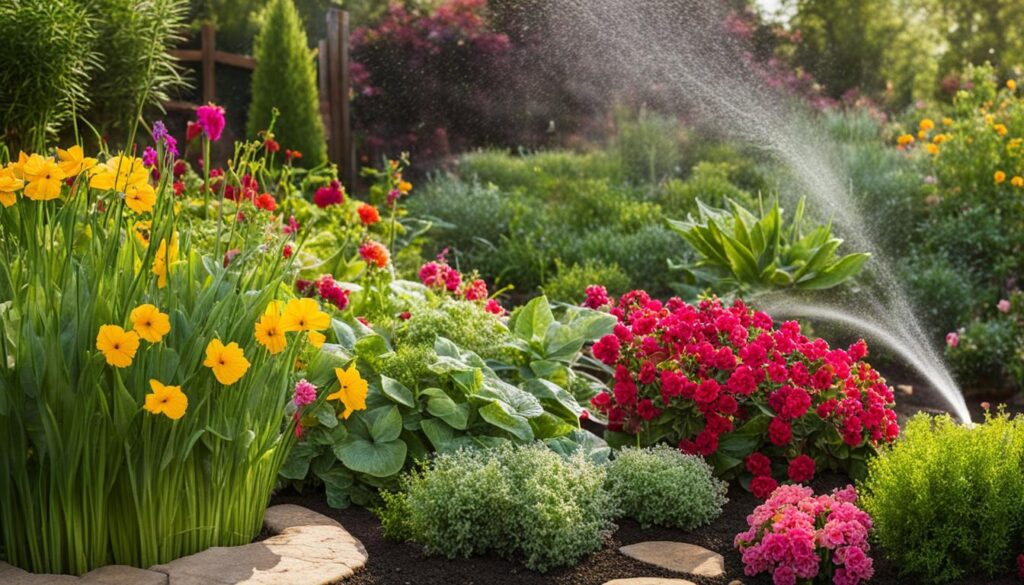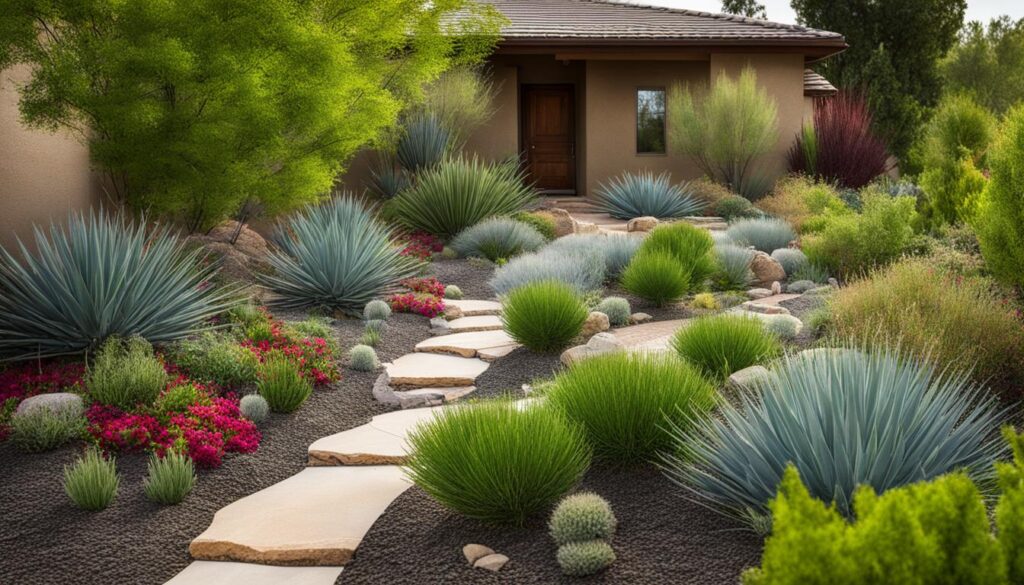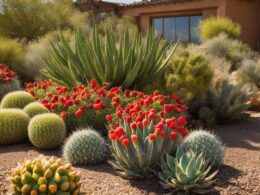Are you looking to reduce your water footprint and unlock the full potential of your garden? Implementing water-efficient irrigation systems is the key to achieving both goals. By using innovative methods specifically designed for xeriscapes, you can minimize water waste and ensure your plants receive the water they need without excessive runoff or evaporation.
Key Takeaways:
- Water-efficient irrigation systems are essential for xeriscapes
- Drip irrigation and soaker hoses are preferred methods for minimizing water waste
- Maintenance is crucial to ensure the effectiveness of the system
- Proper irrigation practices can contribute to water conservation
- Designing a water-wise irrigation system improves efficiency and extends the life of the system
Using Drip Irrigation Systems
Drip irrigation systems are an excellent choice for efficiently watering your plants, allowing you to save water while ensuring your plants receive the moisture they need. With drip irrigation, you can water plants separately, delivering water directly to their root zones, minimizing waste and maximizing efficiency.
One of the key components of drip irrigation systems is the use of emitters, micro-spray stakes, or tapes. These devices deliver water at low pressure directly to the plants, ensuring that the water goes exactly where it’s needed. This targeted approach reduces evaporation and runoff, allowing the plants to absorb the water effectively.
Installing a drip irrigation system is a straightforward process, and the system can be easily expanded as your garden grows or if you decide to add new plants. With the ability to water each plant individually, you have greater control over how much water each plant receives, allowing you to tailor the watering to their specific needs. This flexibility is especially beneficial for gardens with different types of plants that may require varying amounts of water.
By using drip irrigation systems, you can save water and ensure your plants thrive. Whether you’re growing flowers, vegetables, or even trees, drip irrigation can be a game-changer in keeping your garden healthy and vibrant.
Improving Existing Sprinkler Irrigation Systems
When it comes to existing sprinkler irrigation systems, there are a few key factors to consider in order to improve their efficiency and effectiveness. Proper coverage is essential to ensure that every part of your garden receives adequate water. Without proper coverage, certain areas may suffer from a lack of moisture, leading to shallow root development and reduced plant health.
To ensure proper coverage, it’s important to adjust the sprinkler heads accordingly. This will help distribute the water evenly across your garden, avoiding areas of overwatering or underwatering. Additionally, incorporating devices such as bubblers and micro-sprays can further enhance the efficiency of your sprinkler system by ensuring that the water is targeted directly at the root zones of your plants.
One important aspect to keep in mind is that while sprinkler irrigation is commonly used for watering lawns, it may not produce optimal growth results for other types of plants. This is because sprinkler systems can result in greater wet-to-dry soil fluctuations compared to drip irrigation. Therefore, if you have a diverse garden with different types of plants, it’s worth considering alternative irrigation methods, such as drip irrigation, for specific areas to ensure the best possible results.
By taking these steps and making the necessary adjustments, you can improve the efficiency and effectiveness of your existing sprinkler irrigation system. With proper coverage and targeted watering, you can ensure that your plants receive the water they need for healthy growth, while minimizing water waste and promoting a more sustainable approach to gardening.
Proper Irrigation Practices for Small Gardens
In small gardens, proper irrigation practices are essential to ensure the health and vitality of your plants. By following these guidelines, you can maximize water efficiency and ensure that your plants receive the water they need.
Water at the Base of Plants
When watering your small garden, it is best to focus on watering at the base of the plants, rather than spraying water over the leaves and foliage. This helps to minimize evaporation and ensures that the water reaches the roots where it is needed most. You can achieve this by using a hose with a nozzle that allows for targeted watering or by incorporating small basins around each plant. These basins concentrate the water at the roots, providing direct hydration.
Watering by Hand
For new plantings in small gardens, it is recommended to water by hand. This allows for rapid and deep watering, ensuring that the newly planted roots receive ample moisture. Once the soil has settled around the plants, a drip irrigation system can be used to maintain consistent moisture levels. Watering by hand also allows you to closely monitor the water needs of each plant and adjust accordingly.
Vary Watering Techniques
It’s important to consider the specific watering needs of different areas in your small garden. Turf areas, such as lawns, may require more frequent watering to maintain their lushness. Shrub borders and flower beds, on the other hand, may require less watering. Consider the exposure and slope of each area and adjust your watering schedule accordingly. By tailoring your watering techniques to the specific needs of each plant and area, you can ensure optimal growth and minimize water waste.
Designing a Water-Wise Irrigation System
Creating a water-wise irrigation system is essential for conserving water and ensuring the optimal health of your plants. By implementing the following key considerations, you can design a system that is efficient, effective, and environmentally friendly.
Separate Valves for Turf and Plant Areas
One important aspect of a water-wise irrigation system is using separate valves for turf and plant areas. This allows you to control the watering needs of different areas of your garden more effectively. By grouping plants with similar water requirements on the same valve, you can ensure that each area receives the appropriate amount of water without any wastage.
Install a Backflow Preventer
Installing a backflow preventer is crucial to safeguard against contamination of the drinking water supply. This device prevents irrigation water from flowing back into the main water line, ensuring that your garden’s water does not mix with the potable water supply. By incorporating a backflow preventer into your system, you can assure the safety and integrity of your water source.
Strategically Placed Emitters
When designing a water-wise irrigation system, it’s important to install emitters strategically. Emitters should be placed around the dripline of plants, ensuring that enough emitters are present to wet the root zone adequately. This targeted approach to watering minimizes waste and ensures that plants receive the water they need for optimal growth and health.
Use Mulch to Conserve Moisture
Mulching is a highly effective way to conserve moisture in your garden and promote water-wise irrigation. By covering the soil around your plants with a layer of mulch, you can reduce evaporation and inhibit weed growth. Mulch also helps to regulate soil temperature and prevent erosion. This simple addition to your irrigation system can have a significant impact on water conservation and the overall health of your garden.
When designing a water-wise irrigation system, consider the implementation of separate valves, backflow preventers, strategically placed emitters, and mulch. These elements will ensure that you maximize water conservation, minimize waste, and create a sustainable and thriving garden.
Conclusion
Efficient irrigation systems are essential for water conservation, particularly in xeriscapes. By implementing water-wise practices, you can minimize water waste and maximize the potential of your garden while reducing your water footprint.
Drip irrigation and soaker hoses are highly recommended for their ability to deliver water directly to the roots of plants, reducing evaporation and runoff. These methods ensure that plants receive the water they need without excessive waste or loss. Additionally, improving existing sprinkler systems and practicing proper irrigation techniques can further enhance efficiency.
To optimize your irrigation system, consider using technology such as smart controllers and sensors. These tools can help you monitor and adjust water usage based on the specific needs of your plants and the environmental conditions. By using separate valves for different areas of your garden and grouping plants with similar water needs, you can ensure efficient water distribution.
Ultimately, by embracing efficient irrigation systems and practicing water-wise techniques, you can contribute to water conservation efforts and create a thriving, sustainable xeriscape. Not only will you save water, but you will also enjoy a beautiful and vibrant garden that reflects your commitment to environmental stewardship.











